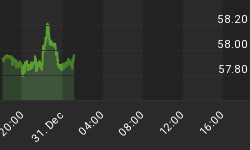Tina Turner a few years ago had a hit song "What's Love Got To Do With it?"
That same question given a few word changes could easily be asked today of the financial scene. "What's Neutral Got To Do With It?" For a longtime the Federal Reserve has pushed the idea a neutral interest rate demeanor symbolizes the Holy Grail of monetary policy.
Trouble is, like the original Holy Grail there have been numerous reported sighting so far but few confirmations. After 11 interest rates hikes and apparently more still to come, a typhoon in the energy sector and a couple of havoc-wreaking hurricanes and signs that inflation is on the rise, many observers appear to believe the U.S economy is a lot like the energizer bunny - just keeps on going.
Bulls seem to like the current valuations, arguing their case for relativity, stocks versus bonds, the former being cheap, the latter expensive in their view. They also like to cite earnings growth, you remember them, predicting double-digit jumps in 2006. Of late they've been cackling about the strong dollar and money flows, suggesting that part of the dollar's recent buoyancy might be coming from foreign investors. Given the run-up in many foreign equity markets, the argument goes, these foreign investors now view U.S. stocks as cheap on a relative basis.
Bears, on the on the other hand, suggest earnings are bumping into strong headwinds, higher energy prices and interest rates and rising inflation, not to leave out falling investor confidence as measured by the University of Michigan consumer index. Then there is that little bit about consumer spending based on what is rapidly become known as equitization (Put down those tomatoes, we didn't coin the term!), consumers pulling equity from their home to keep the spending bunny energized.
No less a financial deity than Sir Alan the Maestro Man recently felt the need to comment. (By the way, the charge that homeowners are using their home equity like ATM machines is literally true. A friend recently acquired an equity line of credit from a big money center bank and one of the first things he received in the mail after his loan was approved was a Pin number and an ATM card.) Greenspan expressed concern about equity withdrawals as a percent of consumers' spending patterns. Though off its high, it remains well above the 15-year average. The implication for GDP is clear should this merry go round suddenly halt.
If Greenspan's comments should strike you as somewhat strange, given that he's the guy in the eyes of many who fueled the ATM game by holding rates abnormally low for an abnormally long time, you're not alone. Now that Greenspan's successor, Ben Bernanke, has been named, another question arises. Given the markets apparent positive reaction to the announcement by President Bush, is that reaction owing to Greenspan's departure or to clearing up the uncertainty about who was next in line? Or is it both?
And that brings us back to neutrality. What is it, how will we recognize it should it ever appear, when will that be and who saw it last are just a few questions we suppose the great unwashed are not supposed to ask. Well, just last week investors may have received a pretty good idea of what it is when Janet Yellen, president of the San Francisco Federal Reserve, suggested it may recline somewhere between 3.5 and 5.5 percent. Trouble is the upper end of that range, 5.5 percent, is well above current consensus and seemed to roil the markets.
Perhaps the best investors can do is recall Dante's comment about the hottest places in hell being preserved for those who maintain their neutrality during times of crisis.
















